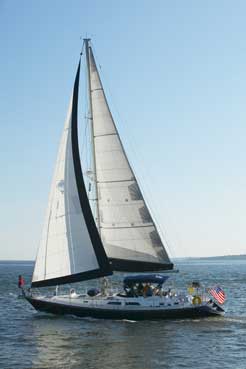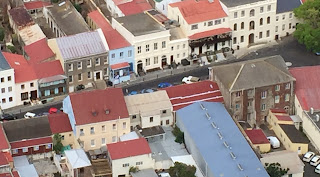We departed Salvador on
February 16th, as a mini WARC, sailing with TULA MHOR, SANDVITA, TAKEOFF,
The OWL, and ALTAIR heading for Cabedelo Brazil about 450 NM up the coast. ALTAIR took off straight for Grenada as they
needed to the get pulled for a little hull work. 3 days before the wind put us in Cabedelo
after a bumpy ride, caused by 20 knots of wind on our beam, especially for the
1st 24 hours. Our
destination, Marina Jacare, was 6 miles
or so up a fairly shallow, wide muddy river with currents as high a 6 knots
driven by the tides. We could only get
into a slip during slack tide which lasted for ½ hour once per day, but the
AURORA knew that and arrived exactly at slack tide and managed to back into a
slip unscathed and aided by zero current. Cabedelo is quite and laid back compared to
Salvador so relaxation was once again the norm. There is a
good size artisan market about a ten minute walk up the river and every
day for the last 30 years this guy blows out the Bolero at sunset on his
saxophone while getting paddled around the river by that market:
He is now a local celebrity
having blown that tune out more times than anyone else in the world now
estimated to be over 10,000 Boleros.
Other than that there is not a lot happening aside from the marina
restaurant and a bar (both of which are friendly and provide great food and
drink) so we rented a car for a week to check out the local region. We arrived at Inga, a petroglyph site about
100 KM north of Cabedelo and the majority of the carvings are on one stone
about 80 feet long and 7 feet tall:
This artifact is located in
the bed of a river accessible only during the dry season for about half of the
year. You can sense that this was a
sacred site. The carving is still precise
and deeply carved into the granite.
Considering it is estimated to be 6,000 years old the art is still crisp. It is easy to make out forms depicting ears
of corn, humans, fish, flying creatures, stars and some other things described
by our guide, which require a bit more imagination. The ancient local tribes left only a few tell
tales as their temples, markets and homes were made of wood, mud and thatch
thus did not make it to the present like the stone structures built by their
neighbors in the Andes or Central America.
But enough with the cultural enrichment.
Back to our quest for food and drink.
Our next destination being the town of Praia (beacg) Da Pipa. We headed for the coast on some rough roads, over
many a hill and dale, cruising trough a few small typical Brazilian towns best
described as lacking wealth. We arrived
Praia Da Pipa in the dark. It’s a good
size beach town:
... frequented mostly by Brazilian tourists. We stood out.
We finally found our Pousada – a Brazilian style small hotel come
B&B:
Very cute and
confortable. A few nights of A/C caused
our comfort factor to climb. It was a 5-minute
stroll to the beach and center of town. We walked to the center arriving about 8:00
PM:
There were a few folks
hanging out but not too much drama. It
turns out that this town does not come alive until around 10:00 at night and
picks up steam for hours finally shutting down around sunrise. Partying is the local lifestyle. You know what they say “when in Rome…” So we
sucked it up for a few days and followed local custom. The girls dragged us through a few high-end
boutiques until the pain was too great causing the boys to enact a pre-planned
retreat to a bar terrace over looking the street action. After 2 days of bars and a few respectable restaurants
we surfed some waves in Dolphin Bay and checked out many bathing suits on the
fairer sex which were materially challenged in classic Brazilian style… the
dolphins often coming in close enough to swim with (we were told), must have
been on vacation. On the way back to Cabedelo we stopped at a large fishing
village and selected a large fish which they cooked up for our lunch while we
sipped large beers – (did we ever mention the coldest beer (by far) in the
world is consistently served in Brazil) - sitting under a palapa with our toes
dug into beach sand - watching the waves.
We finally got back to AURORA and planned our next local assault. This time on the Historic Center of Joao
Passeo and then a tour of their botanic gardens – a 20 minute car ride from the
marina. Their historic center is an area
about 3 blocks by 5 blocks in size with plenty of old and often neglected
buildings centered around another San Francisco church – this one being a 16th
century convent – very impressive and in great nick. The intrepid explorers from SANDVITA, TULA
MHOR and AURORA don’t look displeased in this one of the many ornate halls
offered by the convent for our inspection:
And the church itself is not
too shabby – better described as ornate:
The Botanic garden seemed to
be busy when we arrived. On closer
inspection we found it to be populated by many very pregnant ladies with their
professional photographers snapping serious bump shots… and then we found the
garden is only opened twice a day (sometimes) for guided tours and we missed
it. Our best course of action was a
hasty retreat to the Marina to discuss the weirdness of that afternoon in the
B-garden. The next day about half of the
ARC boats took a tour to the 16th century well kept town of Olinda,
a UNESCO World Heritage site about 100KM south of Cabedelo. We walked the town for about 4 hours and in a
few pictures you can hopefully see why it is a UNESCO site. Just across the river is the port town of
Recife:
Olinda enjoys a popular
carnival – some decorations stay up year around in a ‘museum’ for visitors to
enjoy until they are used in the next carnival:
The views from the top of
town in all directions are memorable:
Eilo could not resist a new
hat:
And more 16th
century churches:
Unfortunately or fortunately
it is time to provision, get ready for the last leg of the WARC and leave
Brazil. A 2300 NM passage up the coast
of Brazil, across the equator, and then offshore to Grenada is in our immediate
future. We leave on the 28th
of Feb and should arrive Grenada by the 15th of March. We’ll let you know how that goes.

























